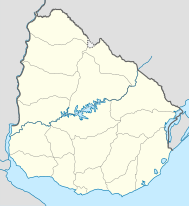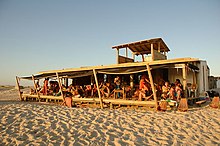Cabo Polonio
| Cabo Polonio | ||
|---|---|---|
|
Coordinates: 34 ° 24 ′ S , 53 ° 47 ′ W Cabo Polonio on the map of Uruguay
|
||
| Basic data | ||
| Country | Uruguay | |
| Department | Rocha | |
| Residents | 95 (2011) | |
| Detailed data | ||
| height | 15 m | |
| Waters | Atlantic | |
| Time zone | UTC -3 standard time (UYT) | |
| Website | ||
| panorama | ||
Cabo Polonio is a small fishing and seaside resort in the Rocha department on the Atlantic coast of Uruguay .
location
Cabo Polonio is located on a rocky plateau on the Atlantic coast in the southeast of the Rocha department, between the seaside resorts of Valizas and La Pedrera , about 260 km from the capital Montevideo . Its distance to the northern border of neighboring Brazil is around 60 kilometers. The place is at the tip of a sickle-shaped peninsula that juts out into the Atlantic. Its side facing the open ocean offers excellent surfing opportunities thanks to the surf and waves. The bay on the inside of the peninsula is a popular seaside resort with its sheltered sandy beaches.
Cabo Polonio is not connected to the road network or to the public supply of electricity and water. The place can be reached from the main road Ruta 10 " Juan Díaz de Solís ", 7 km away, on foot, by horse or by four-wheel drive . The area is not to be electrified in the future either, in order to preserve its “wild” and original state.
history
In the area around Cabo Polonio there are more than 4,000 years old traces of settlements of the indigenous people ( Charrúas , Yaros , Guanaes , Chanaes ). However, the peninsula did not get its name until the 16th century. It was named after Juan Díaz de Solís , who discovered the peninsula in January 1516 during his expedition in search of a western sea route to India and gave it the name " Cabo Apolonio " ("Apollo Cape"). From this the name "Cabo Polonio" arose over time. Another participant of this expedition, Francisco de Torres, owes the three offshore "Torres Islands" their name, as his caravel sank there in 1516. Francisco de Torres was later one of the few survivors of this expedition, which ended on the Río de la Plata .
The first settlement of the peninsula can also be traced back to a shipwreck. On January 31, 1753, the captain and owner Joseph Polonio stranded at this point with his Spanish galleon " Nuestra Señora del Rosario, Señor San Joseph y las Animas " on the way from Cádiz to Buenos Aires . Due to the similarity of the name, some sources still assume that the place was named after this captain. On board the ship there were 318 people, some of whom stayed on the peninsula and began to settle there. In the course of the European colonization of Uruguay in the 19th century, as a result of which the last Charrúas were exterminated, sealers and fishermen in particular came to Cabo Polonio.
Attractions
One of the town's greatest attractions is its sheltered beaches, which are framed by large shifting dunes . These reach heights of up to 50 m and are among the largest in South America. The hinterland with its untouched hills (" monte nativo " or " monte autóctono ") and its many small wetlands testify to the earlier appearance of the Uruguayan coastal landscape. One of the country's symbols can be seen from afar - the two- row pokeweed - which is also known as the ombú tree in Uruguay .
At the tip of the peninsula is the Faro de Cabo Polonio , which opened in 1881 . The beacon, which is located on a hill, is an important aid to navigation in the sea area, which is dangerous due to numerous islands and underwater rocks. Its range is 21.80 nautical miles. It sends its light signal every 12 seconds. Inspired by this, Jorge Drexler wrote the album "12 seconds of darkness" ( 12 segundos de oscuridad ) in 2006 . In 1976 the lighthouse was listed as a historical monument. Until 1907, the operating company of the lighthouse was also responsible for the hunt for the numerous seal species found here. One of the world's largest sea lion colonies is located on the Torres and Castillo Grande Islands off the coast. You can also see whales and dolphins here .
National park
Efforts to protect the flora and fauna around Cabo Polonio have a long history. The river valley of the Arroyo Valizas and Cabo Polonio were declared "forest reserves" ("Reserva Forestal") in September 1942. The shifting dunes between the peninsula and Punta del Diablo were declared in July 1966 as "natural monuments" ("Monumento Natural"). The region around Cabo Polonio also belonged to the "Reserva de Biosfera Bañados del Este" , which was included in the UNESCO program "Man and Biosphere" in 1976 . Finally, in May 1984, the region was declared a “wetland of international importance” according to the Ramsar Convention . Another decree on nature protection from 1992 included the " Laguna de Castillos " and " Aguas Dulces " and Cabo Polonio.
Despite these numerous efforts to protect the cultural landscape and the unique ecosystem , it could not be prevented that the rapidly expanding tourism and its associated rampant development as well as uncontrolled forestry led to an increasing deterioration for flora and fauna. During the military dictatorship from 1973 to 1985, great efforts were made to reforest the shifting dunes, some of which have already led to their disappearance. Therefore, by a decree of July 20, 2009, the area around Cabo Polonio was declared a national park and included in the "National System of Protected Areas" ("Sistema Nacional de Áreas Protegidas").
This protected area includes the three Torres islands "La Rasa", "La Encantada" and "El Islote" as well as the islands of the Castillo Grande "Isla Seca" and "Isla del Marco", the coastal waters within 5 nautical miles. It is bounded to the north by the Arroyo Valizas river and to the west by Ruta 10. Its approximately 18 km long coastline extends in the south to plot number 1.577, while in the east the five-mile zone forms the national park border.
Residents
The population of the place is consistently small. Mainly fishermen, craftsmen and the staff of the lighthouse live here. In the tourist high season from January to March several restaurants, pubs and guest houses are open.
Cabo Polonio had 95 inhabitants at the 2011 census, of whom 60 were men and 35 were women.
| year | Residents |
|---|---|
| 1963 | 58 |
| 1975 | 36 |
| 1985 | 53 |
| 1996 | 103 |
| 2004 | 72 |
| 2011 | 95 |
Source: Instituto Nacional de Estadística de Uruguay
Individual evidence
- ↑ Web portal ( Memento of the original from December 20, 2011 in the Internet Archive ) Info: The archive link was inserted automatically and has not yet been checked. Please check the original and archive link according to the instructions and then remove this notice. from Cabo Polonio (multilingual)
- ^ Antonio de Herrera: Islas Y Tierrafirme Del Mar Oceano . Real Academia de la Historia.
- ↑ Archivo General de la Nación, Uruguay. Archivo General Administrativo, Caja 4, Carpeta 6, Documento 1. Folio 21, 24, 25, 65 vuelta. Montevideo, Febrero de 1753 a Agosto de 1760
- ^ Archivo General de la Nación, Argentina. Registro de Navíos, Legajo 053, Dispatcher 008, Folio 3.Montevideo, Febrero de 1753
- ↑ with the decree 266/966
- ↑ see also the website of "The Ramsar Convention on Wetlands"
- ↑ see Law No. 17.234 ( Memento of the original of August 5, 2016 in the Internet Archive ) Info: The archive link was automatically inserted and not yet checked. Please check the original and archive link according to the instructions and then remove this notice. establishing SNAP
- ↑ Statistical data from the Instituto Nacional de Estadística de Uruguay , accessed on September 26, 2012
- ↑ Statistical data ( MS Word ; 172 kB) of the Instituto Nacional de Estadística de Uruguay 1963–1996
- ↑ Statistical data ( MS Excel ; 38 kB) of the Instituto Nacional de Estadística de Uruguay 2004



